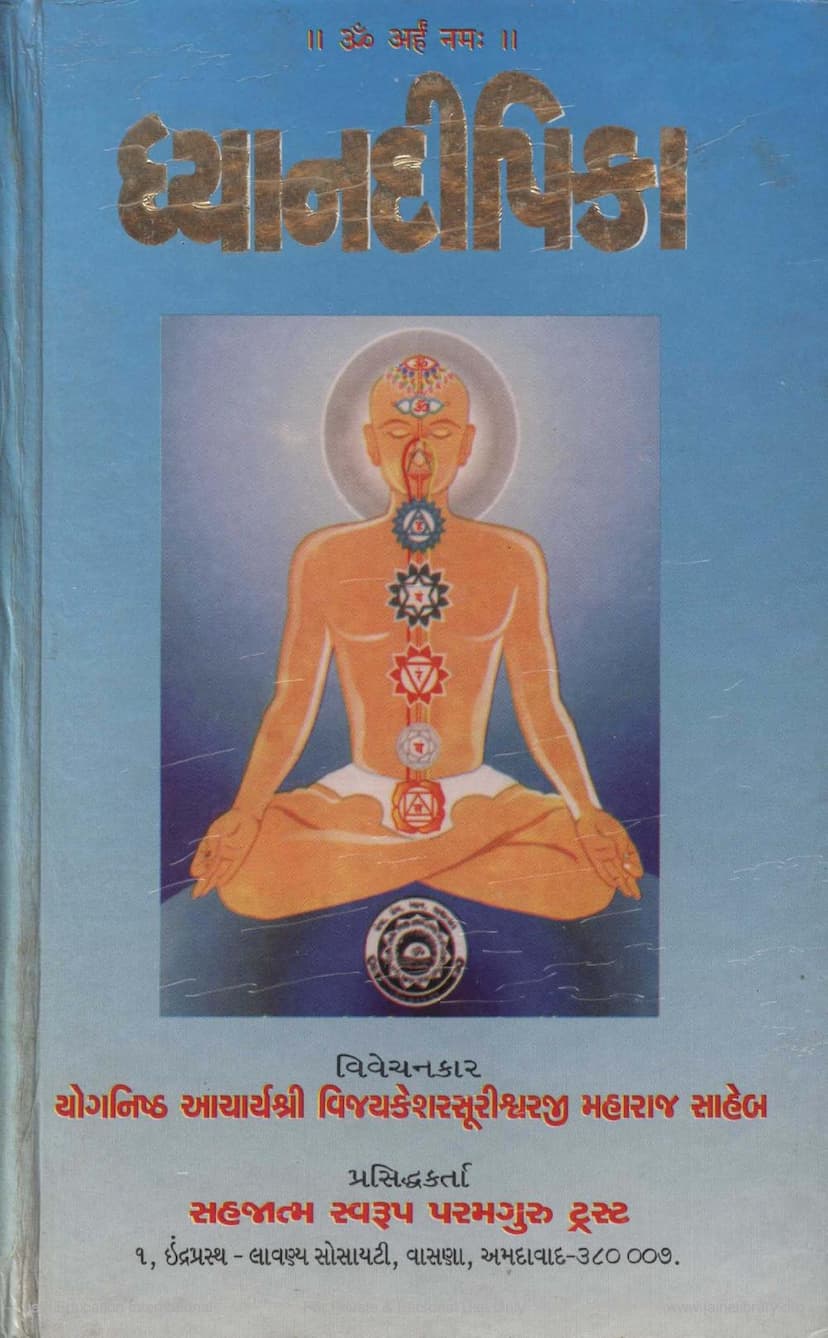Dhyanadipika
Added to library: September 1, 2025

Summary
Certainly! Based on the provided text, here's a comprehensive summary of the Jain text "Dhyanadipika":
Title: Dhyanadipika (The Lamp of Meditation) Author/Compiler: Sakalchandra Gani Upadhyay Commentary/Translation: Acharya Vijay Keshar Surishwarji Maharaj Publisher: Sahajatmaswarup Paramguru Trust, Ahmedabad Language: Primarily Sanskrit, with Gujarati commentary and translation. Catalog Link: https://jainqq.org/explore/004538/
Overview:
"Dhyanadipika" is a Jain text compiled by Sakalchandra Gani Upadhyay, with a detailed commentary and translation provided by Acharya Vijay Keshar Surishwarji Maharaj. The publisher is the Sahajatmaswarup Paramguru Trust, Ahmedabad. The text is written in Sanskrit and contains 245 verses (Gathas and Shlokas) covering the essence of meditation, the path to liberation, and righteous conduct.
Author's Background (Sakalchandra Gani):
- Sakalchandra Gani was a disciple of Danavijayji and is believed to have studied under Shriman Hiravijayji Suri.
- His demise likely occurred before Hiravijayji Suri's passing in Vikram Samvat 1950.
- The estimated time of the compilation of "Dhyanadipika" is around Vikram Samvat 1621, placing Upladhyaya Sakalchandraji in the 16th century.
- While his birthplace is uncertain, a legend suggests he was born into a merchant community in Surat. He renounced his worldly life after a poignant incident involving his wife and his practice of meditation.
- He is also credited with composing the "Satrabhhedi" and "Ekvis Prakari Puja," as well as a small work in Magadhi language titled "Shrutraswad."
Content and Structure:
The book is structured into nine chapters, guiding the reader through various aspects of meditation and spiritual practice:
- Chapter 1: Mangalacharan, Subject, and Instructions: This introductory chapter includes auspicious invocations, outlines the book's subject matter, and offers guidance to aspiring meditators. It emphasizes the importance of scripture, the nature of the soul, and the necessity of contemplation.
- Chapter 2: Bhavanas (Meditative Contemplations - Part 1): This chapter focuses on four key Bhavanas: Darshan Bhavana (Contemplation of Right Faith), Charitra Bhavana (Contemplation of Right Conduct), and Vairagya Bhavana (Contemplation of Detachment).
- Chapter 3: Bhavanas (Meditative Contemplations - Part 2): This chapter delves into twelve further Bhavanas, starting with Anitya Bhavana (Contemplation of Impermanence) and continuing through other essential contemplations like Asharan (helplessness), Sansar (cycle of existence), Ekatva (aloneness), Anyatva (otherness), Ashuchi (impurity), Ashrava (influx of karma), Samvara (cessation of karma), Nirjara (eradication of karma), Purushartha (effort), Dharma (righteousness), Lok (universe), and Bodhi (enlightenment).
- Chapter 4: Hita Shiksha (Beneficial Teachings): This section offers practical advice and philosophical insights on meditation, emphasizing its role as a tool for liberation, the futility of worldly pursuits without self-realization, the nectar of meditation, and discussions on who can meditate, questioning the validity of meditation for hypocrites and those in religious garb without genuine realization.
- Chapter 5: Artadhyana (Mournful Meditation): This chapter details the characteristics of Artadhyana, categorized into four types: arising from unfavorable conjunctions, separation from favorable ones, illness, and intense desires or resolutions (Niyana).
- Chapter 6: Raudradhyana (Fiery Meditation): This chapter elaborates on the nature of Raudradhyana, focusing on its four forms stemming from violence, falsehood, theft, and the protection of possessions, highlighting the detrimental consequences of such mental states.
- Chapter 7: Dharmadhyana (Righteous Meditation): This chapter extensively explains Dharmadhyana, including aspects of Ashtanga Yoga (eight limbs of yoga).
- Chapter 8: Pindasthadi Four Types of Meditation: This section describes four categories of meditation: Pindastha (meditation on the physical body), Padmastha (meditation on specific divine forms or syllables), Rupastha (meditation on visualized forms), and Rupatita (meditation beyond form).
- Chapter 9: Shukladhyana (Pure Meditation): This final chapter details the nature of pure meditation, its stages, and its ultimate goal.
Key Themes:
- The Centrality of Meditation: The book consistently emphasizes meditation as the primary means to achieve liberation (Moksha), self-realization, and the eradication of karmas.
- The Importance of Bhavanas: The twelve Bhavanas are presented as crucial mental states to cultivate, leading towards detachment and a deeper understanding of reality.
- The Nature of Dhyana: The text distinguishes between different types of meditation (Artadhyana, Raudradhyana, Dharmadhyana, Shukladhyana), explaining their characteristics, causes, and effects.
- Self-Discipline and Control: Meditation is presented as a path that requires self-control, detachment from worldly desires, and the mastery of the mind and senses.
- Guidance for Sadhakas: The book offers practical guidance and teachings aimed at spiritual seekers who are devoted to self-discipline and aspire to attain their ultimate well-being.
- Compilation of Wisdom: The author highlights that the text is not entirely original but a compilation of useful aspects from various meditation texts, making it a valuable resource for practitioners.
Overall Purpose:
"Dhyanadipika" serves as a guiding light ("Deepika") for those seeking to understand and practice meditation. It aims to lead individuals towards self-realization, the shedding of karmic bonds, and ultimately, liberation (Moksha) by illuminating the path of meditation and spiritual discipline. The commentary by Acharya Vijay Keshar Surishwarji Maharaj makes the profound teachings accessible in Gujarati, further enhancing its utility.